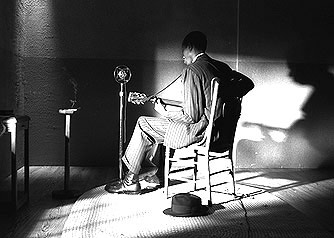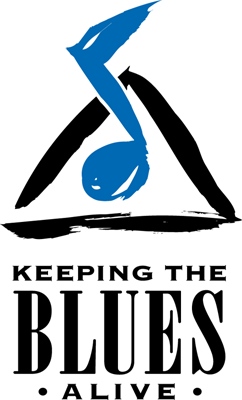
A shy man, Johnson once recorded in a San Antonio hotel room facing the wall for the entire session as several Mexicans looked on. Later rescuing Johnson from jail that night after a police beating, the session producer got a call from Johnson explaining that he was lonesome. The producer asked him to explain what he meant, to which Johnson replied, "I'm lonesome, and there's a lady here. She wants fifty cents, and I lacks a nickel."
His best work was recorded in 1935-36. Johnson played with some of the best Bluesman that ever lived, including Howlin' Wolf, Elmore James, Memphis Slim, Johnny Shines, and Sonny Boy Williamson. Johnson learned the Blues from two masters, Charlie Patton, and Son House, along with a relatively unknown Bluesman, Ike Zinnemen. Robert and Ike would sit on tombstones at night and compose darker occult Blues songs laced with phantoms, demons, and Satan himself.
Like many true Bluesmen, Johnson lived the life he sang about, filled with vice, and ending of course with his own murder. Sonny Boy Williamson cautioned Robert not to drink from an open whiskey bottle after an attempt to rekindle an old romance with a married woman. Johnson was dead from strychnine, and buried in an unmarked grave several days later. Blues great Robert Jr. Lockwood. is Robert Johnson's step son.
Through the popularity and influence of only 29 songs (41 performances in total including alternate takes), Robert Johnson has come to be seen as one of the most important, and certainly the most famous, of the Delta bluesmen. One of the most striking qualities of the handful of recordings which comprise Robert Johnson's output is the great variety of sounds and styles emanating from a single performer with an acoustic guitar.
Those who saw Johnson play may have also heard the rumors. Like anyone possessing extraordinary talent and skill, jealous peers circulated vicious rumors about Johnson. In fact, it was the great Son House who stated "He sold his soul to play like that".
Johnson's peculiarities added to the rumors. Some fans thought that he had the "evil eye". Actually, he suffered from a small cataract. Also, it has been reported that Johnson turned from the audience while playing, and would leave suddenly from a performance, sometimes even during breaks in his set. While today such actions are not considered odd. In those days they were. Many people took it to mean that he was a man with something to hide.
In reality, Johnson was doing some things that great musicians still do today. It is common to leave a performance in order to avoid mob scenes and the repetitive company that one keeps after a show. Edward Van Halen also would turn from the crowd during club shows- to hide his technique from other guitarists.
Johnson's choice of instructor did nothing to slow the Legend from spreading. This instructor, Ike Zinnerman, supposedly learned to play the guitar at night sitting atop tombstones in old country churchyards. In southern black communities it was a well-known notion that one could go to the crossroads and sell one's soul to the devil. The concept dates back to African Folklore. The diety Esu was believed to be the guardian of the crossroads, and was an intermediate between gods and humans. When Christianity was brought to African Culture, these pagan gods were labeled as being similar to the devil. Hence, the concept that one could find the devil at a crossroad. In celtic tradition, the bodies of the unholy were buried outside of town near crossroads to preserve consecrated ground.
Witchcraft and the devil are prominent topics in early blues. Johnson's lyrics are no exception. With songs like "Hell-Hound On My Trail", "Me And The Devil Blues" and "Cross Road Blues", it is no wonder that he caused such wild speculation.

